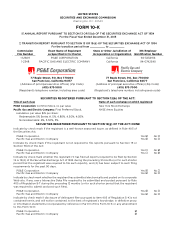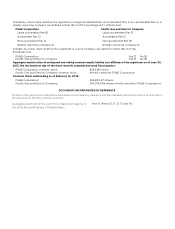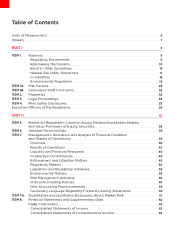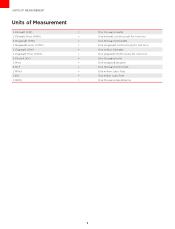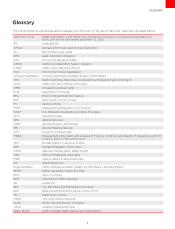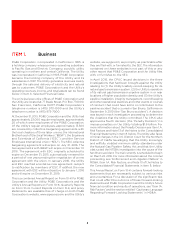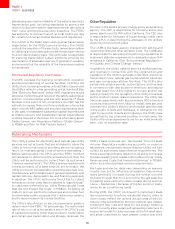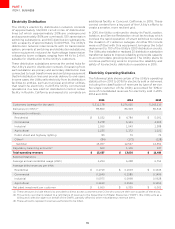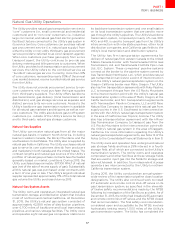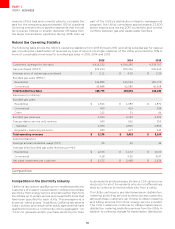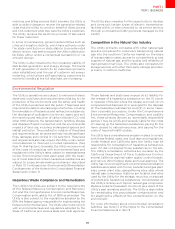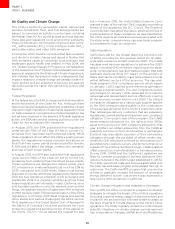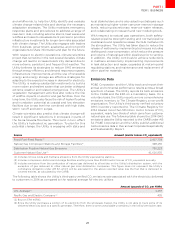PG&E 2015 Annual Report Download - page 19
Download and view the complete annual report
Please find page 19 of the 2015 PG&E annual report below. You can navigate through the pages in the report by either clicking on the pages listed below, or by using the keyword search tool below to find specific information within the annual report.
11
PART I
ITEM1.BUSINESS
energy use. (See “Legislative and Regulatory Initiatives”
in MD&A for additional information on specific CPUC
proceedings.)
From time to time, the CPUC may use incentive ratemaking
mechanisms that provide the Utility an opportunity to
earn some additional revenues. For example, the Utility
has earned incentives for the successful implementation of
energy eciency programs. (See “Results of Operations”
in MD&A.) These mechanisms can also create financial
risk. For a discussion of the re-opened proceeding to
review incentive revenues awarded for the 2006-2008
energy eciency cycle, see “Rehearing of CPUC Decisions
Approving Energy Eciency Incentive Awards” in Note
13 of the Notes to the Consolidated Financial Statements
in Item 8. below.
Base Revenues
General Rate Cases
The GRC is the primary proceeding in which the CPUC
determines the amount of base revenue requirements
that the Utility is authorized to collect from customers
to recover the Utility’s anticipated costs, including return
on rate base, related to its electricity distribution, natural
gas distribution, and Utility owned electricity generation
operations. TheCPUC generally conducts a GRC every
three years. The CPUC approves the annual revenue
requirements for the first year (or “test year”) of the GRC
period and typically authorizes the Utility to receive annual
increases (known as “attrition rate adjustments”) in revenue
requirements for the subsequent years of the GRC period.
Attrition rate adjustments are generally provided for cost
increases related to increases in invested capital and inflation.
Parties in the Utility’s GRC include the ORA and TURN,
who generally represent the overall interests of residential
customers, as well as a myriad of other intervenors who
represent residential and other customer interests.
For more information about the Utility’s current GRC
proceeding, see “Regulatory Matters −2017 General Rate
Case” in MD&A.
Natural Gas Transmission and Storage Rate Cases
The CPUC determines the Utility’s authorized revenue
requirements and rates for its natural gas transmission
and storage services in the GT&S rate case. In its 2015
GT&S rate case, the Utility has requested that the CPUC
approve a total annual revenue requirement of $1.263 billion
for the Utility’s anticipated costs of providing natural gas
transmission and storage services for 2015. The Utility
also requested revenue increases of $83 million in 2016
and $142 million in 2017. See “Regulatory Matters – 2015
Gas Transmission and Storage Rate Case” in MD&A for
additional information.
Cost of Capital Proceedings
The CPUC periodically conducts a cost of capital proceeding
to authorize the Utility’s capital structure and rates of
return for its electric generation, electric and natural gas
distribution, and natural gas transmission and storage
rate base. The CPUC has authorized the Utility’s capital
structure through 2017, consisting of 52% common equity,
47% long-term debt, and 1% preferred stock. The CPUC
also set the authorized ROE at 10.40%. The CPUC also
adopted an adjustment mechanism to allow the Utility’s
capital structure and ROE to be adjusted if the utility bond
index changes by certain thresholds on an annual basis.
During 2015, the adjustment mechanism was not triggered
so the Utility’s authorized ROE will remain at 10.40% for
2016. On February 12, 2016, a proposed decision was
issued, that, if approved by the CPUC, will preclude the
Utility from using the mechanism before its next cost of
capital application. As a result, if the proposed decision is
approved, the Utility’s capital structure and ROE will not
be adjusted for 2017. The CPUC will review the Utility’s
capital structure and ROE for 2018 in the Utility’s next
cost of capital proceeding. The Utility is required to file
its 2018 cost of capital application by April 20, 2017.
Electricity Transmission Owner Rate Cases
The FERC determines the amount of authorized revenue
requirements, including the rate of return on electric
transmission assets, that the Utility may collect in rates
in the TO rate case. The Utility generally files a TO rate
case every year. The FERC typically authorizes the Utility
to charge new rates based on the requested revenue
requirement, subject to refund, before the FERC has issued
a final decision. These FERC-approved rates are included:
1) by the CPUC in the Utility’s retail electric rates and are
collected from retail electric customers; and 2) by the
CAISO in its Transmission Access Charges to wholesale
customers. (See “Regulatory Matters – FERC TO Rate
Cases” in MD&A.) The Utility also recovers a portion of its
revenue requirements for its wholesale electric transmission
costs through charges collected under specific contracts
with wholesale transmission customers that the Utility
entered into before the CAISO began its operations.
These wholesale customers are charged individualized
rates based on the terms of their contracts.
Revenues to Recover Energy Procurement and
Other Pass-Through Costs
Electricity Procurement Costs
California investor-owned electric utilities are responsible
for procuring electricity required to meet bundled customer
demand, plus applicable reserve margins, that are not
satisfied from their own generation facilities and existing
electricity contracts. The utilities are responsible for
scheduling and bidding electric generation resources,
including electricity procured from third parties or the
wholesale market, to meet customer demand according
to which resources are the least expensive (i.e., using the
principles of “least-cost dispatch”). In addition, the utilities
are required to obtain CPUC approval of their procurement
plans based on long-term demand forecasts. The CPUC
has approved the Utility’s procurement plan covering
2012 through 2024.


